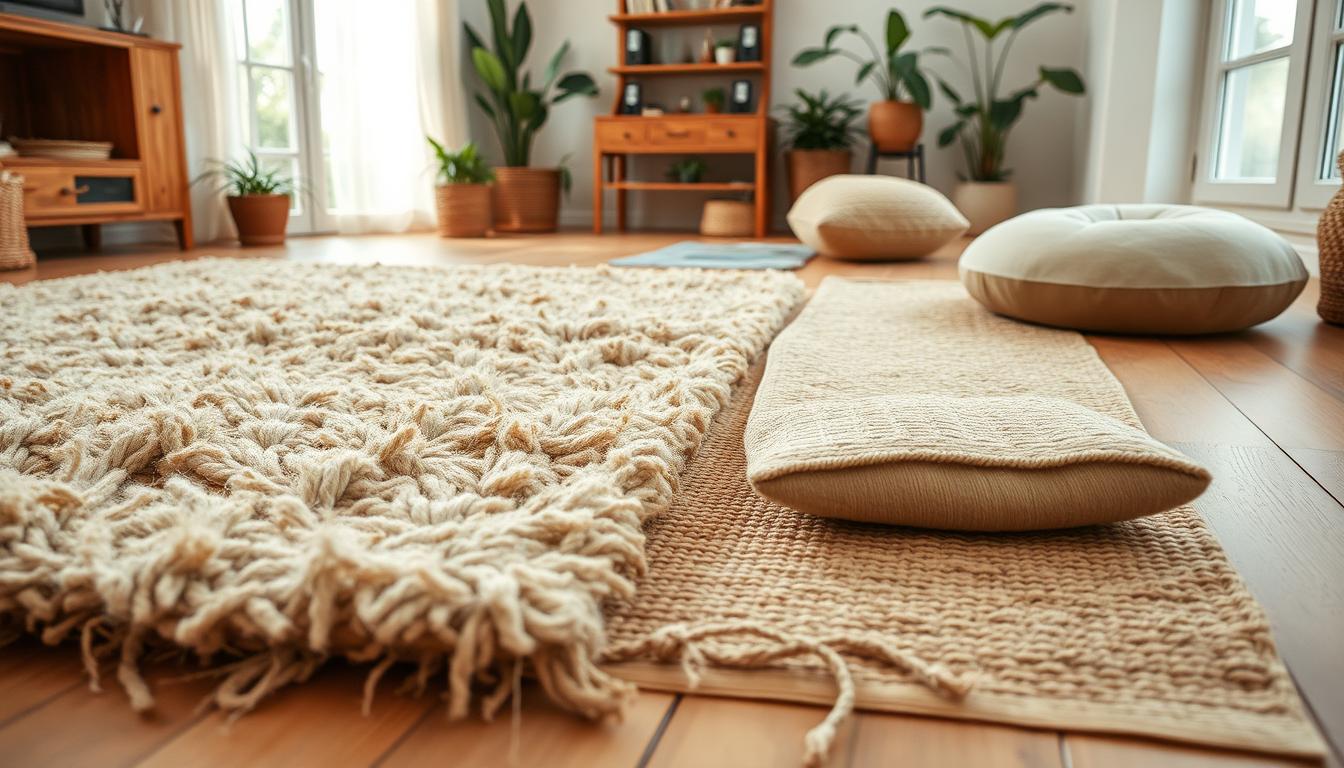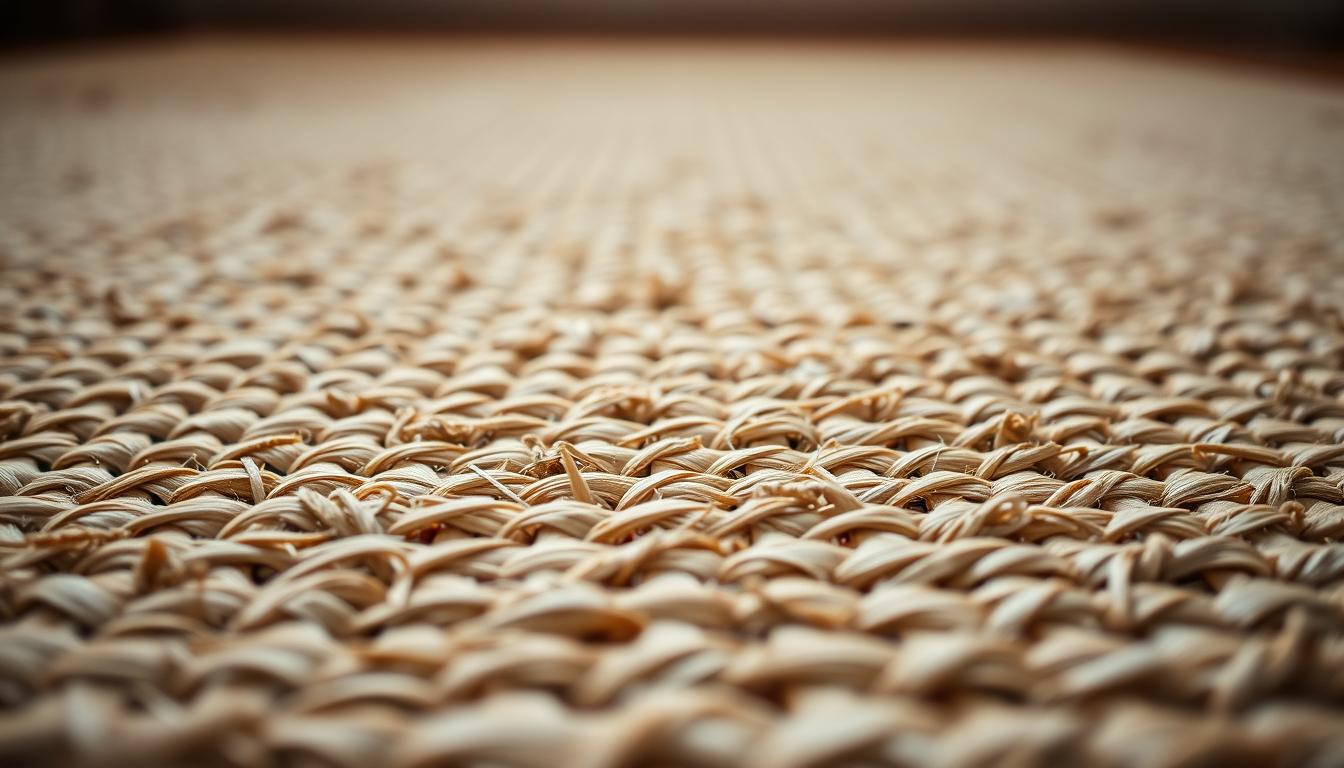
Sisal Rug Care: 5 Key Tips for Long-Lasting Beauty
What if your favorite natural floor covering could outlast synthetic alternatives without complicated maintenance? While these earthy textiles from agave plants dominate modern homes, their care requirements defy common assumptions about durability. Let’s unravel the truth.

Natural fiber floor coverings thrive with intentional upkeep. Unlike mass-produced options, their organic structure demands tailored strategies—vacuum with soft bristles twice weekly, skip harsh attachments, and never use steam cleaners. Even sunlight exposure requires planning to prevent fading.
Owners often struggle with subtle challenges: moisture warping fibers, natural earthy scents, or stains that cling stubbornly. Our comprehensive cleaning guide reveals why dry methods work best and how rotation prevents uneven wear. You’ll discover when DIY solutions suffice versus needing professional intervention.
Key Takeaways
- Vacuum 1-2 times weekly using brush attachments to preserve fiber integrity
- Schedule professional dry cleaning every 12-24 months for deep maintenance
- Address spills immediately with blotting—never rubbing—to prevent staining
- Rotate your floor covering quarterly to distribute foot traffic patterns
- Use moisture-wicking pads beneath furniture legs to avoid indentation
Understanding the Beauty and Durability of Sisal Rugs
Woven from agave leaves thriving in tropical climates, these earth-friendly floor coverings offer more than rustic charm. The plant regrows rapidly after harvest, making it a sustainable choice for eco-conscious homes. Unlike synthetic alternatives, they decompose naturally without harming the environment.
What sets these textiles apart? Their tightly twisted fibers resist crushing under heavy use. High-traffic areas like hallways or living rooms maintain their textured appearance for years. Compared to jute, another popular natural material, they hold shape better and require less frequent maintenance.
Neutral beige and cream tones blend effortlessly with coastal, minimalist, or farmhouse décors. The subtle variations in each strand create visual depth that mass-produced carpets can’t replicate. Designers often layer them with patterned accents to balance organic simplicity with bold statements.
For allergy sufferers, natural fiber rugs act as allies. Their open weave prevents dust and pollen accumulation, improving indoor air quality. Built-in insulation properties help regulate room temperatures—cool underfoot in summer, gently warm during winter months.
Discover more advantages of plant-based floor coverings, from their moisture-resistant structure to their role in biophilic design. Properly maintained, they become enduring centerpieces that age with character.
Sisal Rug Care
Your natural floor covering’s longevity begins before dirt enters your space. Walk-off mats at every entrance capture 80% of outdoor debris, acting as frontline defenders. Pair this with a strict no-shoes policy to block bacteria and pesticides from reaching delicate fibers.

Weekly vacuuming removes fine particles that grind into textiles like sandpaper. Use a suction-only setting or soft brush attachment—motorized beater bars unravel twisted strands. When spills occur, these embedded particles rise like sediment, creating stubborn stains.
Natural materials require different solutions than synthetic counterparts. Avoid all moisture-based cleaners, as water swells plant fibers and causes permanent warping. Instead, follow our natural fiber cleaning guide for safe dry methods using cornstarch or baking soda.
Professionals recommend deep cleaning every 12-24 months. Seek specialists experienced with plant-based textiles—many standard services use damaging wet techniques. This hybrid approach balances daily diligence with expert interventions, preserving your investment for decades.
How to Clean and Dry Your Sisal Rug Effectively
Accidents happen, but quick action preserves your floor covering's beauty. Immediate response prevents permanent marks while maintaining the material's organic texture. Let’s explore methods that protect delicate strands without harsh chemicals.
Spot Cleaning Techniques for Quick Fixes
Blot spills within 10 seconds using white paper towels. Press firmly—never scrub—to lift liquids upward. For crumbs or solids, sweep inward with a spoon’s edge to contain the mess.
Use pH-neutral solutions on a clean cloth, not directly on fibers. Test cleaners in hidden areas first. Baking soda works for grease, while cornstarch absorbs oil. Our step-by-step guide details stain-specific approaches.
Proper Drying Methods to Prevent Moisture Damage
After treating stains, place dry towels over damp areas. Weight them with books for 2 hours to extract residual moisture. Use fans to circulate air—never apply direct heat from hairdryers.
Elevate the textile during drying if possible. Check for hidden dampness by pressing a tissue against backing fibers. Repeat drying steps until no moisture transfers.
When to call professionals: Stubborn marks requiring water-based solutions or odors lingering after 48 hours signal expert help needed. Specialized dry cleaning services preserve structural integrity better than DIY attempts.
Dealing with Odor and Freshening Up Natural Rugs
That subtle earthy aroma from your floor covering isn’t a flaw—it’s nature’s signature. Plant-based textiles release organic compounds that diminish over weeks, but environmental factors can amplify their presence. Let’s explore how to balance freshness with the material’s inherent character.
Immediate Freshening Techniques
Open windows during dry mornings to circulate air without introducing humidity. Position fans at opposite ends of the room for cross-ventilation—15 minutes daily reduces stagnant odors. For sunlight therapy, limit exposure to 2-hour intervals to prevent fading while neutralizing smells.
| Odor Factor | Impact | Solution |
|---|---|---|
| High Humidity | Traps organic particles | Use dehumidifiers at 45% RH |
| Poor Airflow | Concentrates natural scents | Rotate furniture for clear pathways |
| Moisture Exposure | Activates plant compounds | Apply baking soda weekly |
Sprinkle baking soda lightly across the surface using a mesh strainer for even distribution. Let it sit 3-4 hours before vacuuming—this absorbs odors without damaging fibers. For persistent smells near entryways, manage natural textile odors by repeating monthly.
Monitor scent changes seasonally. Summer humidity may require weekly treatments, while winter’s dry air lets you space them out. If odors become sharp or mold-like, consult specialists—this signals moisture damage needing professional attention.
Preventing Stains and Managing Spills on Sisal Rugs
Every spill becomes a race against time when protecting natural fibers. Liquids act like glue, binding dirt particles to delicate strands. Immediate action prevents these collisions from becoming permanent marks.
Step-by-Step Spill Response
First 10 seconds: Grab white paper towels. Press firmly—don’t scrub—to absorb liquids upward. For solids, use a spoon’s edge to gather debris without grinding it deeper.
Choosing cleaners: Always test solutions on hidden areas first. Apply pH-neutral agents to cloths, never directly on fibers. Baking soda tackles grease, while cornstarch absorbs oils.
Final steps: Blot cleaned areas with water-dampened towels to remove residue. Place dry towels over the spot, weighting them with books for 2 hours. Run fans nearby to speed drying.
Different spills demand tailored approaches:
- Water-based: Blot quickly—evaporation leaves particles behind
- Oil-based: Use cornstarch paste, let sit overnight
- Organic: Scrape solids first, then apply baking soda solution
Prevent future issues with moisture-resistant sprays designed for plant-based textiles. Keep humidity below 55% to discourage liquid absorption. Rotate furniture quarterly to avoid concentrated spill zones.
Utilizing Professional Cleaning and Maintenance Strategies
Professional care elevates natural textiles from seasonal accents to enduring investments. While daily upkeep preserves surface cleanliness, specialized treatments every 12-24 months combat deep-seated grime that accelerates wear. Choosing the right approach requires understanding material science and certified techniques.

Dry Cleaning vs. Wet Cleaning: Which Is Best?
Dry methods dominate natural fiber maintenance for good reason. Technicians spread absorbent compounds across surfaces, using rotary brushes to lift embedded dirt without moisture. This prevents fiber swelling while removing allergens trapped in woven layers.
| Method | Process | Best For |
|---|---|---|
| Dry Cleaning | Compound application + mechanical brushing | Routine deep cleaning |
| Controlled Wet | pH-balanced mist + extraction | Severe stains |
Wet cleaning becomes necessary only for stubborn spills penetrating multiple layers. Certified teams use sprayers that emit 90% less water than home machines, followed by industrial suction to prevent residue.
How to Choose a Specialized Cleaning Service
Verify IICRC certification—this ensures training in plant-based material protocols. Ask providers:
- How many natural fiber projects they complete monthly?
- Do they carry insurance covering dye bleeding or shrinkage?
- Can they share before/after photos of similar textiles?
Red flags include vague process descriptions or promises of "like-new" results. Authentic specialists emphasize preserving organic textures rather than aggressive transformations. For complex scenarios, reference our cleaning guide to assess service compatibility.
Natural and DIY Remedies for Cleaning Sisal Fibers
Transform everyday pantry staples into powerful allies for maintaining your natural floor coverings. Simple ingredients like baking soda and white vinegar tackle odors and stains without compromising delicate materials. These solutions work with—not against—the organic properties of plant-based textiles.
Homemade Deodorizing Solutions with Baking Soda and Vinegar
Mix equal parts vinegar and water in a spray bottle for gentle odor neutralization. Lightly mist the solution onto a clean cloth, then dab affected areas. Baking soda absorbs lingering smells—sprinkle it evenly, let sit for two hours, then vacuum thoroughly.
For stubborn stains, combine 1 teaspoon mild dish soap with 2 cups cool water. Always test mixtures on hidden corners first. Blot spills immediately using upward motions to prevent liquid from spreading deeper into fibers.
Professional dry cleaning remains essential for deep maintenance. For routine care, reference this specialized maintenance guide when DIY methods reach their limits. Eco-conscious owners can explore sustainable cleaning approaches for seasonal refreshes.
Key reminders: Avoid soaking materials, rotate cleaning zones to prevent wear patterns, and store unused mixtures in sealed containers. With consistent care, your textile retains its earthy charm for years.
FAQ
How often should I maintain natural fiber floor coverings?
Regular upkeep is essential. Vacuum weekly using a brush attachment to remove dirt and debris. Avoid excessive moisture, as it can weaken fibers. Rotate the piece every 6–12 months to ensure even wear.
Can I use water to clean spills on these textiles?
Water can cause permanent damage, like warping or staining. Instead, blot spills immediately with a dry cloth. For stubborn spots, lightly dampen the cloth with a mix of mild soap and cold water, then blot gently.
What’s the best way to eliminate odors from natural materials?
Sprinkle baking soda liberally over the surface, let it sit for 15–30 minutes, then vacuum thoroughly. For deeper freshening, mix equal parts white vinegar and water in a spray bottle, mist lightly, and allow to air-dry completely.
Are professional services safe for delicate fibers?
Yes, but choose providers experienced with natural fiber rugs. Dry cleaning is often recommended to prevent moisture damage. Always confirm their methods align with the manufacturer’s guidelines before hiring.
How do I prevent permanent stains after accidents?
Act quickly. Scoop or blot solids first, then apply cornstarch or talcum powder to absorb liquids. Let it sit overnight before vacuuming. Avoid rubbing, as this pushes spills deeper into the weave.
Can homemade solutions replace commercial cleaners?
For minor issues, yes. A paste of baking soda and water can tackle light stains, while vinegar diluted in water neutralizes odors. Test any solution on a hidden area first to ensure colorfastness.
Why does my floor covering feel rough over time?
Dirt particles can settle between fibers, causing abrasion. Regular vacuuming and occasional brushing with a stiff-bristle broom help maintain softness. Avoid harsh chemicals, which strip natural oils and worsen texture.









